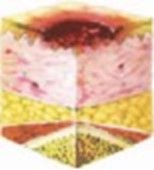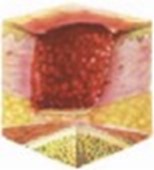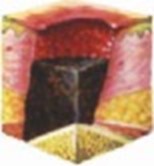A pressure ulcer (PU) is localised injury to the skin and/or underlying tissue usually over a bony prominence, such as the heel or sacrum, as a result of pressure, or pressure in combination with shear (National Pressure Injury Advisory Panel/European Pressure Ulcer Advisory Panel/Pan Pacific Pressure Injury Alliance [NPIAP/EPUAP/PPPIA], 2019). They range in severity from categories 1–4, and unstageable and suspected deep tissue injury (DTI) are also now included in the NPUAP/EPUAP/PPPIA categorisation (Table 1).
Table 1. Pressure ulcer categories
| Category 1 |
 Non-blanchable erythema, intact skin with non-blanchable redness of a localised area usually over a bony prominence. Darkly pigmented skin may not have visible blanching; its colour may differ from the surrounding area. Non-blanchable erythema, intact skin with non-blanchable redness of a localised area usually over a bony prominence. Darkly pigmented skin may not have visible blanching; its colour may differ from the surrounding area. The area may be painful, firm, soft, warmer or cooler as compared to adjacent tissue. |
| Category 2 |
 Partial-thickness loss of dermis presenting as a shallow open ulcer with a red pink wound bed, without slough. May also present as an intact or open/ruptured serum-filled blister. Presents as a shiny or dry shallow ulcer without slough or bruising (bruising indicates suspected deep tissue injury). Partial-thickness loss of dermis presenting as a shallow open ulcer with a red pink wound bed, without slough. May also present as an intact or open/ruptured serum-filled blister. Presents as a shiny or dry shallow ulcer without slough or bruising (bruising indicates suspected deep tissue injury). This category should not be used to describe skin tears, tape burns, perineal dermatitis, maceration or excoriation. |
| Category 3 |
 Full-thickness tissue loss. Subcutaneous fat may be visible but bone, tendon or muscle are not exposed. Slough may be present but does not obscure the depth of tissue loss. May include undermining and tunneling. The depth of a category 3 pressure ulcer varies by anatomical location. The bridge of the nose, ear, occiput and malleolus do not have subcutaneous tissue and category 3 ulcers can be shallow. In contrast, areas of significant adiposity can develop extremely deep category 3 pressure ulcers. Bone/tendon is not visible or directly palpable. Full-thickness tissue loss. Subcutaneous fat may be visible but bone, tendon or muscle are not exposed. Slough may be present but does not obscure the depth of tissue loss. May include undermining and tunneling. The depth of a category 3 pressure ulcer varies by anatomical location. The bridge of the nose, ear, occiput and malleolus do not have subcutaneous tissue and category 3 ulcers can be shallow. In contrast, areas of significant adiposity can develop extremely deep category 3 pressure ulcers. Bone/tendon is not visible or directly palpable. |
| Category 4 |
 Full-thickness tissue loss with exposed bone, tendon or muscle. Slough or eschar may be present on some parts of the wound bed. Often include undermining and tunneling. The depth of a category 4 pressure ulcer varies by anatomical location. The bridge of the nose, ear, occiput and malleolus do not have subcutaneous tissue and these ulcers can be shallow. Category 4 ulcers can extend into muscle and/or supporting structures (e.g. fascia, tendon or joint capsule) making osteomyelitis possible. Exposed bone/tendon is visible or directly palpable. Full-thickness tissue loss with exposed bone, tendon or muscle. Slough or eschar may be present on some parts of the wound bed. Often include undermining and tunneling. The depth of a category 4 pressure ulcer varies by anatomical location. The bridge of the nose, ear, occiput and malleolus do not have subcutaneous tissue and these ulcers can be shallow. Category 4 ulcers can extend into muscle and/or supporting structures (e.g. fascia, tendon or joint capsule) making osteomyelitis possible. Exposed bone/tendon is visible or directly palpable. |
| Unstageable depth unknown |
 Full-thickness tissue loss in which the base of the ulcer is covered by slough (yellow, tan, grey, green or brown) and/or eschar (tan, brown or black) in the wound bed. Until enough slough and/or eschar is removed to expose the base of the wound, the true depth, and therefore category, cannot be determined. Stable (dry, adherent, intact without erythema or fluctuance) eschar on the heels serves as ‘the body’s natural (biological) cover’ and should not be removed. Full-thickness tissue loss in which the base of the ulcer is covered by slough (yellow, tan, grey, green or brown) and/or eschar (tan, brown or black) in the wound bed. Until enough slough and/or eschar is removed to expose the base of the wound, the true depth, and therefore category, cannot be determined. Stable (dry, adherent, intact without erythema or fluctuance) eschar on the heels serves as ‘the body’s natural (biological) cover’ and should not be removed. |
| Suspected deep tissue injury depth unknown |
| Purple or maroon localised area of discoloured intact skin or blood-filled blister due to damage of underlying soft tissue from pressure and/or shear. The area may be preceded by tissue that is painful, firm, mushy, boggy, warmer or cooler as compared to adjacent tissue. DTI may be difficult to detect in individuals with dark skin tones. Evolution may include a thin blister over a dark wound bed. The wound may further evolve and become covered by thin eschar. Evolution may be rapid exposing additional layers of tissue even with optimal treatment. |
Images in Table 1 reproduced courtesy of National Pressure Ulcer Advisory, European Pressure Ulcer Advisory Panel and Pan Pacific Pressure Injury Alliance (2014) Prevention and Treatment of Pressure Ulcers: Quick Reference Guide. Emily Haesler (Ed). Cambridge Media: Obsbourne Park, Australia
Once a PU has been identified, there needs to be clinical agreement with the PU classification (NPIAP/EPUAP/PPPIA, 2019) to enable prescribing of treatment and care planning.
There is potential for all patients to be at risk of pressure ulceration. However, patients who are critically ill, have a neurological condition, impaired mobility and nutrition, or poor posture and deformity are at a greater risk (National Institute for Health and Care Excellence [NICE], 2014). Patients with a spinal cord injury (SCI) have a PU prevalence of 20–30% in the first one to five years after their injury (Department of Health [DH], 2022).
The Burden of Wounds study reported that PUs accounted for 9% of all wounds managed by the National Health Service (NHS) during 2012/13 (Guest et al, 2015), with a £531.1 million estimated cost to the NHS in managing these wounds and the associated comorbidities (Guest et al, 2017).
There is no single factor which can explain pressure ulcer risk, rather a complex interplay of factors (Coleman et al, 2013). Reduced mobility and sensory perception are two prominent risk factors. However, patients may present with additional risk factors, depending on risk assessment (Box 1).
There is potential for all patients to be at risk of pressure ulceration. However, patients who are critically ill, have a neurological condition, impaired mobility and nutrition, or poor posture and deformity are at a greater risk (National Institute for Health and Care Excellence [NICE], 2014). Patients with a spinal cord injury (SCI) have a PU prevalence of 20–30% in the first one to five years after their injury (Department of Health [DH], 2022).
The Burden of Wounds study reported that PUs accounted for 9% of all wounds managed by the National Health Service (NHS) during 2012/13 (Guest et al, 2015), with a £531.1 million estimated cost to the NHS in managing these wounds and the associated comorbidities (Guest et al, 2017).
There is no single factor which can explain pressure ulcer risk, rather a complex interplay of factors (Coleman et al, 2013). Reduced mobility and sensory perception are two prominent risk factors. However, patients may present with additional risk factors, depending on risk assessment (Box 1).
BOX 1. PRESSURE ULCERATION RISK FACTORS (PURPOSE T) |
|
These risk factors can be intrinsic, such as mobility, sensory impairment, nutrition, or extrinsic, such as pressure, shear, moisture, patient beliefs.
Pressure ulcer risk assessment is required in all patients within six hours of acute admission or on the first visit within a community setting, using a recognised pressure ulcer risk assessment tool (such as Braden, Waterlow, PURPOSE T [Pressure Ulcer Risk Primary or Secondary Evaluation Tool]) (NICE, 2014). Clinical judgement should also be employed and local policy followed when assessing a patient’s risk of developing a pressure ulcer. It is also vital that patients are regularly reassessed, e.g. when washing or dressing and during dressing changes, as pressure ulcers can develop rapidly.
Once patient risk factors are identified (such as those in Box 1), also including socio-demographic and behavioural factors, a plan can be incorporated into their care to help prevent the development of avoidable pressure ulcers. This should be completed in partnership with the individual. Indeed, identifying and preventing pressure ulcers is considered an indication of the quality of care given (Vowden and Vowden, 2015).
Reassessment of patients’ PU risk factors and plan of care, including wound assessment, should be completed in accordance with local PU policy and in agreement with the patient. This should include the patient’s ability to undertake activities of daily living (ADLs), as a person who neglects their personal hygiene and has reduced mobility will be increasing their risk of PU. Pressure ulcers can occur as a result of neglect or self-neglect through acts of omissions, including ignoring medical, emotional or physical care needs. Where this is evident, it is likely to result in preventable skin damage (Department of Health and Social Care, 2018).
Pressure ulcer risk assessment is required in all patients within six hours of acute admission or on the first visit within a community setting, using a recognised pressure ulcer risk assessment tool (such as Braden, Waterlow, PURPOSE T [Pressure Ulcer Risk Primary or Secondary Evaluation Tool]) (NICE, 2014). Clinical judgement should also be employed and local policy followed when assessing a patient’s risk of developing a pressure ulcer. It is also vital that patients are regularly reassessed, e.g. when washing or dressing and during dressing changes, as pressure ulcers can develop rapidly.
Once patient risk factors are identified (such as those in Box 1), also including socio-demographic and behavioural factors, a plan can be incorporated into their care to help prevent the development of avoidable pressure ulcers. This should be completed in partnership with the individual. Indeed, identifying and preventing pressure ulcers is considered an indication of the quality of care given (Vowden and Vowden, 2015).
Reassessment of patients’ PU risk factors and plan of care, including wound assessment, should be completed in accordance with local PU policy and in agreement with the patient. This should include the patient’s ability to undertake activities of daily living (ADLs), as a person who neglects their personal hygiene and has reduced mobility will be increasing their risk of PU. Pressure ulcers can occur as a result of neglect or self-neglect through acts of omissions, including ignoring medical, emotional or physical care needs. Where this is evident, it is likely to result in preventable skin damage (Department of Health and Social Care, 2018).
CASE STUDY
This male patient with a SCI presented to his GP surgery feeling unwell with a category 4 pressure ulcer (Table 1) to the sacrum and bilateral ischial tuberosities. A high volume of exudate was being produced and there was malodour. Before the development of the pressure ulcer, he had been receiving no other community care services. The GP arranged hospital admission, where the plastics team diagnosed Fournier’s gangrene, which resulted in a long admission and failed skin graft. The plastics team also prescribed an extended course of oral antibiotics. A referral was made to the community nursing team (CNT) for his discharge home, as he required application of negative pressure wound therapy (NPWT), and to ensure that pressure relief equipment was in place.
The CNT visited the patient at home and performed a holistic assessment, including wound assessment (this involved photography) and PURPOSE T risk assessment, which highlighted his risk factors (mobility, current pressure damage, sensory perception, moisture and poor nutritional status). A pressure ulcer care plan was implemented to address the risk factors, including referral to a dietician and advice on a positioning schedule.
Within his first week at home, the tissue viability nurse (TVN) visited and performed a comprehensive assessment. NPWT was subsequently discontinued as it required daily dressing changes. This was mainly due to the patient wishing to transfer independently using a banana board (transfer board) and the dressings becoming dislodged. As a result of the patient’s risk of infection and the high volume of exudate being produced, the TVN prescribed antimicrobial and superabsorbent dressings. During the assessment with the TVN, he presented with local and systemic signs of wound infection (high exudate, odour from the wound on dressing removal, and delayed healing — systemic infection is a stage of infection when microorganisms spread throughout the body [International Wound Infection Institute, 2022]). Due to his SCI, he was not able to express pain from the PU. Current antibiotics were being taken as prescribed, and wounds swabs were taken and the GP informed.
Both the TVN and GP advised hospital admission, but he declined. This was mostly due to his recent long admission and being away from his wife, who suffered with her own mental health issues. As a compromise, the TVN liaised with the plastics team and the patient agreed to weekly outpatient appointments for ongoing monitoring, with daily CNT visits continuing for wound care, assessment and clinical observations.
Unfortunately, within four weeks of being at home, the patient declined these CNT visits. He and his wife were very private, they had not had community services visiting in the past and did not like this happening, as the patient felt that it was having a negative impact on his wife’s mental health. The severity of the PU, risk factors and his health had been explained to him daily by the CNT and during the TVN assessments, and he was assessed as having mental capacity to make his own decisions. He was able to communicate his needs, he retained information from previous visits regarding his treatment and pressure prevention care plan, he understood the severity of his condition and was able to weigh up that, if left untreated, his current condition was life-threatening.
A further compromise was therefore reached whereby the patient would attend the GP surgery three times per week, replacing dressings himself between appointments, with the weekly outpatient appointment to plastics continuing. Two members of the CNT attended the GP surgery appointments, with weekly TVN assessment. Clinical observations (including bloods if required) and wound assessment were documented. This indicated that he had ongoing infection and was at risk of sepsis. Hospital admission was again advised, but he continued to decline. Home visits were thus offered, as he was still attending the surgery during the winter and his dressings were extremely saturated with exudate. However, his preference was to continue attending the appointments at the surgery three times a week.
Due to identified complexities with this individual, such as severe pressure damage, self-neglect, resulting in ongoing risk of wound infection and osteomyelitis, a multidisciplinary approach was adopted, incorporating the CNT, TVN, trust safeguarding, GP and plastics team.
Safeguarding perspective
Since the implementation of the Care Act in 2014, self-neglect has been defined as a form of abuse and neglect which comes under the remit of safeguarding adults practice. Safeguarding adults boards (SABs) have a statutory duty to help and protect adults with care and support needs who are experiencing, or at risk of abuse and neglect. Practitioners within health care also have a statutory duty to work with and support those patients who self-neglect (Social Care Institute for Excellence [SCIE], 2018).
SABs have a duty to undertake safeguarding adults reviews (SARs) when an adult with care and support needs has died or suffered serious harm, with the cause suspected or known to be neglect or abuse (including self-neglect). Self-neglect has become the most prevalent type of abuse featured within SARs nationally (Local Government Association, 2022; Box 2).
Box 2. Learning from SARs/Self-neglect research |
|
Self-neglect can arise due to a range of factors rather than simply being someone’s own choice. These factors include mental and physical health, as well as social and environmental factors. It could be a longstanding pattern, a recent change, be linked to loss, past trauma, as well as low self-esteem.
Evidence of good practice recommends (Research in Practice, 2020):
|
Self-neglect can include people both with or without mental capacity, who demonstrate:
- Lack of self-care (neglect of personal hygiene, nutrition, hydration and health, thereby endangering their safety and wellbeing)
- Lack of care of one’s environment (squalor and hoarding)
- Refusal of services that would mitigate the risk of harm
(Government Publications, 2022).
Legal frameworks: consent and Mental Capacity Act (MCA)
There are a few legal frameworks available to consider when responding to self-neglect, such as the Care Act 2014, Mental Capacity Act (MCA) 2005 (Box 3), and Human Rights Act 1998.
Box 3. Mental capacity act |
|
Be clear on your patient’s capacity. If uncertain, then assess this. Mental capacity can be assessed by any healthcare professional (this does not need to be a specialist psychiatrist or social worker), but the person who assesses capacity should be the ‘decision maker’, i.e. the healthcare professional who is delivering/overseeing the patient’s care and treatment.
How to assess mental capacity
Stage 1: does the patient have an impairment and/or disturbance of the mind and brain? (which could be causing them to lack capacity)
Stage 2: can the patient do all of the below (in relation to the self-neglect decision). If the patient is unable to do any one of these, it means they lack capacity for the decision:
(Department for Constitutional Affairs, 2007)
|
From the perspective of working within a community setting, the starting point for healthcare professionals is to be clear about which legal frameworks are underpinning the care and treatment being delivered to the patient, such as:
- Law on consent
- Mental Capacity Act 2005 (England and Wales)/The Adults with Incapacity Act 2000 (Scotland).
However, if healthcare professionals have concerns about a patient’s ability to make decisions, their mental capacity needs to be assessed for the self-neglect decision they are making. If the patient lacks mental capacity (Box 3), professionals should work in the patient’s best interests (Box 4). This involves professionals making decisions about how to provide interventions that are the least restrictive, i.e. keeping them safe while restricting their rights and freedoms as little as possible, and taking into account the patient’s views and wishes (Mental Capacity Act, 2005).
Box 4. |
|
If you are unsure what a best interests decision may be for a patient, apply the checklist (below) to help ensure your decision follows the best interests principles:
Take all of the above into account and weigh up these factors in order to work out what is in the patient’s best interests.
Department for Constitutional Affairs, 2007
|
Professionals also need to be mindful that if the patient is refusing treatment they may not fully understand the risks or consequences involved. Thus, it should be explored if treatment can be delivered in a way that the patient may accept.
Managing this case with the patient having mental capacity
As the patient presented here was deemed to have mental capacity, the authors approached his case through:
- Respecting the patient’s autonomy: treatment or visits could not be forced and his decisions needed to be respected as he had mental capacity. He did not want home visits due to the distress it caused his wife, so they were arranged at the GP surgery. As he did not want to be seen daily, a compromise of three times a week was reached
- Building relationships: consistent staff were used, who took the time to develop a rapport with him and understand his circumstances. It was thereby learnt that he was a carer for his wife whose mental health was impacting his engagement with services
- Multi-agency working: multi-agency meetings involving the GP, district nurses, TVN, safeguarding colleagues and adult social care were held to discuss the risks and how the multidisciplinary team (MDT) could work together to best support the patient (to avoid overlapping appointments, having joint visits where possible, sharing information to save him repeating his story, etc)
- Advance care planning (ACP): as the patient was not accepting a great deal of advice or treatment, inevitably his health would decline. Thus, ACP was important to see what he would want that to look like, e.g. end-of-life care. Parts of MCA can be used, such as advance decisions to refuse treatment (ADRT) and lasting power of attorney (LPA) to give him a sense of more control when his health declined
- Good documentation: this was kept of all discussions, attempts to engage with him and, most importantly, capacity assessments for his self-neglect decisions, as there was the possibility of his health deteriorating and risk of death.
Managing the case if the patient lacked capacity
If the patient discussed here had been found to lack capacity, the case would have needed to be approached differently, namely:
Professionals would make best interests decisions for him —when a patient lacks capacity, consent will not come from anyone else (such as family or carers) unless they have specific legal powers to make decisions, such as being named on a LPA or a court appointed deputy for health and welfare decisions (Gov, 2022)
- Take his views/wishes into account. Treatment may still have been provided at his GP surgery or visits three times a week rather than daily, so it was less distressing for his wife. Where possible, treatment would have been provided in his preferred environment (home or GP surgery). If this was not possible, hospital admission may have been considered, but again within a best interests framework (Box 4)
- Least restrictive options: it may not have been appropriate to take him to hospital or move him to a care home away from his home and wife, which is clearly where he wanted to remain. In the authors’ clinical opinion, just because the patient lacks capacity, it does not give healthcare professionals the right to do what they want.
Mr Justice Munby, a judge in the Court of Protection, said in his famous 2007 judgement: ‘what’s the point of making someone safe, if in doing so you just make them miserable?’ This captures the balancing act between managing risks and the patient’s wishes when considering what is best interests for them.
OTHER LOCAL SERVICES
In cases where patients are refusing treatment or at risk of self-neglect, other services can be involved to offer support/advice, such as:
- Rapid review meetings: within the authors’ trust, pressure ulcers category 3 and above are discussed in these meetings and involve representation from the trust’s safeguarding team. Other health organisations may have similar forums/risk management meetings where these cases can be discussed with wider colleagues for guidance and support
- Exceptional risk forum: Established by the Leeds safeguarding adults board (LSAB), the LSAB exceptional risk forum is a place where agencies can refer cases (including self-neglect) for a multi-agency panel perspective, which offers advice and recommendations on how a patient’s risk can be reduced.
Other SABs may have something similar but named differently, such as vulnerable adults meetings. Check with your local SAB or consider setting one up with multi-agency colleagues.
OTHER MECHANISMS TO SUPPORT SELF-NEGLECT CASES
In the authors’ clinical experience, healthcare professionals should also be aware of other local services/leads to link with when they encounter cases of self-neglect, such as:
- Safeguarding adults/Mental Capacity Act leads where support is required and access to safeguarding supervision
- Local safeguarding adults/self-neglect policies and guidelines, as local SABs will be doing work around self-neglect
- Adult social care, housing, fire services and police, which can provide valuable input, especially in cases involving other aspects of self-neglect, such as hoarding.
CONCLUSION
Self-neglect can be a common feature in complex wound management patients. It is important for healthcare professionals to know about and understand self-neglect in the context of safeguarding adults practice, rather than view it as a lifestyle choice. Self-neglect can have significant consequences to the patient’s physical health, especially if healthcare professionals do not consider adapting their own approaches to work with patients proactively to achieve the best outcomes. Also, a multi-agency approach involving safeguarding and mental capacity expertise is key to supporting healthcare professionals who are delivering care to people who self-neglect.References
Coleman S, Gorecki C, Nelson A, Closs J, Defloor T, H Ruud, et al (2013) Patient risk factors for pressure ulcer development: Systematic review. Int J Nurs Stud 50: 974–1003
Coleman S, Smith I, McGinnis E, Keen J, Muir D, Wilson L, et al (2018) Clinical evaluation of a new pressure ulcer risk assessment instrument, the Pressure Ulcer Risk Primary or Secondary Evaluation Tool (PURPOSE T). J Adv Nurs 74: 407–24
DeJong G, Tian W, Hsieh C-H, Junn C, Karam C, Ballard PH, et al (2013)Rehospitalization in the first year of traumatic spinal cord injury after discharge from medical rehabilitation.Arch Phys Med Rehabil 94(4 Suppl 2): S87–97
Department for Constitutional Affairs (2007) The Mental Capacity Act 2005 Code of Practice. United Kingdom: Crown Copyright
Department of Health (2022) Pressure ulcers: applying All Our Health. Updated 10 June 2022. DH, London. Available online: www.gov.uk/guidance/pressure-ulcers-applying-all-our-health
Department of Health and Social Care (2018) Safeguarding Adults Protocol Pressure Ulcers and the interface with a Safeguarding Enquiry. Available online: https://assets.publishing.service.gov.uk/government/uploads/system/uploads/attachment_data/file/756243/safeguarding-adults-protocol-pressure-ulcers.pdf
Gélis A, Dupeyron A, Legros P, Benaïm C, Pelissier J, Fattal C (2009) Pressure ulcer risk factors in persons with spinal cord injury Part 2: the chronic stage. Spinal Cord 47(9): 651–61
Gov.UK (2022) Pressure ulcers: applying All Our Health. Available online: www.gov.uk/guidance/pressure-ulcers-applying-all-our-health
Government Publications (2022) Statutory guidance — Care and support statutory guidance. Available online: www.gov.uk/government/publications/care-act-statutory-guidance/care-and-support-statutory-guidance
Guest JF, Ayoub N, McIlwraith T, et al (2015) Health economic burden that wounds impose on the National health service in the UK. BMJ Open 5: e009283
Guest JF, Ayoub N, McIlwraith T, et al (2017) Health economic burden that different wound types impose on the UK’s National Health Service. Int Wound J 14: 322–30
International Wound Infection Institute (2022) Wound infection in Clinical Practice; Principles of best practice. Wounds International, London. Available online: www.woundsinternational.com/resources/details/wound-infection-in-clinical-practice-principles-of-best-practice
Jones D (2013) Pressure ulcer prevention in the community setting. Nurs Standard 28(3): 47–55
Leeds Safeguarding Adults Board (LSAB) LSAB Self neglect policy. Available online: www.leedssafeguardingadults.org.uk
Local Government Association (2022) Briefing for practitioners — Analysis of Safeguarding Adults Reviews. Available online: www.local.gov.uk/topics/social-care-health-and-integration/adult-social-care/resources-safeguarding-adults-boards/practitioners
National Health Service (2019) Consent to treatment. Available online: www.nhs.uk/conditions/consent-to-treatment/#:~:text=Consent%20to%20treatment%20means%20a,an%20explanation%20by%20a%20clinician
National Institute for Health and Care Excellence (2014) Pressure Ulcers: Prevention and Management. CG179. NICE, London. Available online: www.nice.org.uk/guidance/cg179
National Pressure Injury Advisory Panel/European Pressure Ulcer Advisory Panel/Pan Pacific Pressure Injury Alliance (2019) Prevention and Treatment of Pressure Ulcers/Injuries. Clinical Practice Guideline. Available online: www.epuap.org/pu-guidelines/
Research in Practice (2020) Working with people who self-neglect. Dartington Trust. Available online: www.researchinpractice.org.uk/media/4833/working_with_people_who_self-neglect_pt_web.pdf
Social Care Institute for Excellence (2018) Self-neglect at a glance. Available online: www.scie.org.uk/self-neglect/at-a-glance
Vowden K, Vowden P (2015) Documentation in pressure ulcer prevention and management. Wounds UK 11(3 supplement): 6–9
Coleman S, Smith I, McGinnis E, Keen J, Muir D, Wilson L, et al (2018) Clinical evaluation of a new pressure ulcer risk assessment instrument, the Pressure Ulcer Risk Primary or Secondary Evaluation Tool (PURPOSE T). J Adv Nurs 74: 407–24
DeJong G, Tian W, Hsieh C-H, Junn C, Karam C, Ballard PH, et al (2013)Rehospitalization in the first year of traumatic spinal cord injury after discharge from medical rehabilitation.Arch Phys Med Rehabil 94(4 Suppl 2): S87–97
Department for Constitutional Affairs (2007) The Mental Capacity Act 2005 Code of Practice. United Kingdom: Crown Copyright
Department of Health (2022) Pressure ulcers: applying All Our Health. Updated 10 June 2022. DH, London. Available online: www.gov.uk/guidance/pressure-ulcers-applying-all-our-health
Department of Health and Social Care (2018) Safeguarding Adults Protocol Pressure Ulcers and the interface with a Safeguarding Enquiry. Available online: https://assets.publishing.service.gov.uk/government/uploads/system/uploads/attachment_data/file/756243/safeguarding-adults-protocol-pressure-ulcers.pdf
Gélis A, Dupeyron A, Legros P, Benaïm C, Pelissier J, Fattal C (2009) Pressure ulcer risk factors in persons with spinal cord injury Part 2: the chronic stage. Spinal Cord 47(9): 651–61
Gov.UK (2022) Pressure ulcers: applying All Our Health. Available online: www.gov.uk/guidance/pressure-ulcers-applying-all-our-health
Government Publications (2022) Statutory guidance — Care and support statutory guidance. Available online: www.gov.uk/government/publications/care-act-statutory-guidance/care-and-support-statutory-guidance
Guest JF, Ayoub N, McIlwraith T, et al (2015) Health economic burden that wounds impose on the National health service in the UK. BMJ Open 5: e009283
Guest JF, Ayoub N, McIlwraith T, et al (2017) Health economic burden that different wound types impose on the UK’s National Health Service. Int Wound J 14: 322–30
International Wound Infection Institute (2022) Wound infection in Clinical Practice; Principles of best practice. Wounds International, London. Available online: www.woundsinternational.com/resources/details/wound-infection-in-clinical-practice-principles-of-best-practice
Jones D (2013) Pressure ulcer prevention in the community setting. Nurs Standard 28(3): 47–55
Leeds Safeguarding Adults Board (LSAB) LSAB Self neglect policy. Available online: www.leedssafeguardingadults.org.uk
Local Government Association (2022) Briefing for practitioners — Analysis of Safeguarding Adults Reviews. Available online: www.local.gov.uk/topics/social-care-health-and-integration/adult-social-care/resources-safeguarding-adults-boards/practitioners
National Health Service (2019) Consent to treatment. Available online: www.nhs.uk/conditions/consent-to-treatment/#:~:text=Consent%20to%20treatment%20means%20a,an%20explanation%20by%20a%20clinician
National Institute for Health and Care Excellence (2014) Pressure Ulcers: Prevention and Management. CG179. NICE, London. Available online: www.nice.org.uk/guidance/cg179
National Pressure Injury Advisory Panel/European Pressure Ulcer Advisory Panel/Pan Pacific Pressure Injury Alliance (2019) Prevention and Treatment of Pressure Ulcers/Injuries. Clinical Practice Guideline. Available online: www.epuap.org/pu-guidelines/
Research in Practice (2020) Working with people who self-neglect. Dartington Trust. Available online: www.researchinpractice.org.uk/media/4833/working_with_people_who_self-neglect_pt_web.pdf
Social Care Institute for Excellence (2018) Self-neglect at a glance. Available online: www.scie.org.uk/self-neglect/at-a-glance
Vowden K, Vowden P (2015) Documentation in pressure ulcer prevention and management. Wounds UK 11(3 supplement): 6–9


